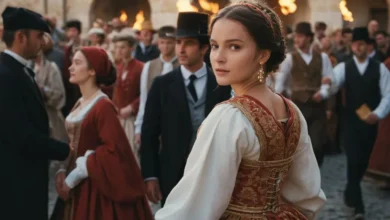traditional-clothing-in-france-basque-costume
Traditional clothing offers a glimpse into the cultural heritage and historical identity of a region. In France, the Basque Country, straddling the southwestern part of the country and parts of Spain, holds a distinctive place with its unique attire known as the Basque costume.
This traditional outfit embodies centuries of tradition, social customs, and artistic craftsmanship. In this article, we will explore the history, significance, key elements, evolution, and contemporary relevance of the Basque costume.
Historical Context
The Basque Country has a rich and complex history, marked by its distinct language, traditions, and cultural practices. The region’s clothing traditions have evolved over centuries, influenced by the diverse socio-economic and environmental factors.
The Basque costume can be traced back to the early medieval period, with its roots deeply embedded in the farming and seafaring communities. It reflects the resilience and adaptability of the Basque people, who have managed to preserve their unique cultural identity through generations.
See also The Zocos Gallegos the traditional footwear with history
The Zocos Gallegos the traditional footwear with history
Key Elements of the Basque Costume
The Basque costume is characterized by several key elements that distinguish it from other regional attires in France. These elements include:
1. The Skirt (Zira)
The most iconic piece of the Basque costume for women is the zira, a full, ankle-length skirt made from wool or cotton. It often features horizontal stripes in red, green, or blue, symbolizing the Basque tricolor. The zira is usually paired with a white blouse, often embroidered with traditional motifs such as flowers, birds, or geometric patterns.
2. The Corset (Esparraguera)
A crucial element of the women’s Basque costume is the esparraguera, a fitted corset that provides structure and shape to the outfit. It is made of sturdy fabric and often features laces at the front. The esparraguera emphasizes the waist and adds to the traditional look of the costume.
3. The Apron (Buzina)
Worn over the skirt, the buzina is an apron that serves both decorative and functional purposes. It is typically made from a contrasting fabric and adorned with intricate lacework or embroidery. The buzina not only adds a layer of modesty but also showcases the craftsmanship of Basque women.
See also The Beret Navarra the accessory with Identity
The Beret Navarra the accessory with Identity
4. The Shawl (Sarrera)
Another important accessory is the sarrera, a shawl that is draped over the shoulders. Made from soft wool or cotton, the sarrera often features embroidered borders or fringes. It serves as both a practical and decorative piece, especially during colder months.
5. The Headgear (Panuelo)
For women, the traditional headgear is a white panuelo, a square scarf tied under the chin. This simple yet symbolic piece signifies marital status and region of origin. For men, the basque beret (txapela) is a hallmark of Basque tradition, often worn tilted to one side.
6. The Shoes (Zokoak)
Traditionally, both men and women wear comfortable shoes suited to the rural and coastal environment of the Basque Country. Women’s shoes are often black leather with rounded toes, while men wear sturdy boots or espadrilles.
Evolution and Contemporary Relevance
Over the years, the Basque costume has undergone changes, influenced by modern fashion trends, urbanization, and globalization. However, it remains an essential part of Basque cultural heritage, especially during festive occasions, such as weddings, traditional festivals, and cultural events. Today, the Basque costume is not only worn by older generations but has also seen a resurgence among the younger population who embrace it as a symbol of regional pride.
Contemporary adaptations of the Basque costume can be seen in fashion shows, cultural exchanges, and even in casual wear. Designers have integrated traditional elements with modern cuts and styles, allowing the costume to evolve while maintaining its historical essence. This adaptability ensures that the Basque costume remains relevant and continues to be a representation of Basque identity in a changing world.
Significance of the Basque Costume
The Basque costume holds deep cultural and symbolic significance. It represents more than just a piece of clothing; it embodies a sense of community, identity, and continuity. The costume is a visual representation of the Basque people’s history, values, and resilience. It serves as a reminder of the past while fostering a sense of pride and belonging in the present.
For many Basques, wearing the traditional costume is an act of cultural preservation and a celebration of their heritage. It is worn during important milestones, such as baptisms, confirmations, and celebrations of Basque culture, highlighting its role as a marker of identity and continuity.
The Basque costume is a cherished symbol of the Basque Country’s cultural heritage. With its intricate details, historical roots, and enduring relevance, it represents a rich tapestry of traditions that continue to shape the identity of the Basque people.
As the Basque Country moves forward in an increasingly globalized world, the Basque costume remains an enduring symbol of regional pride and cultural continuity. Whether worn for ceremonial occasions or reinterpreted in modern fashion, it continues to be a powerful reminder of the deep connections between the Basque people and their ancestral past.
